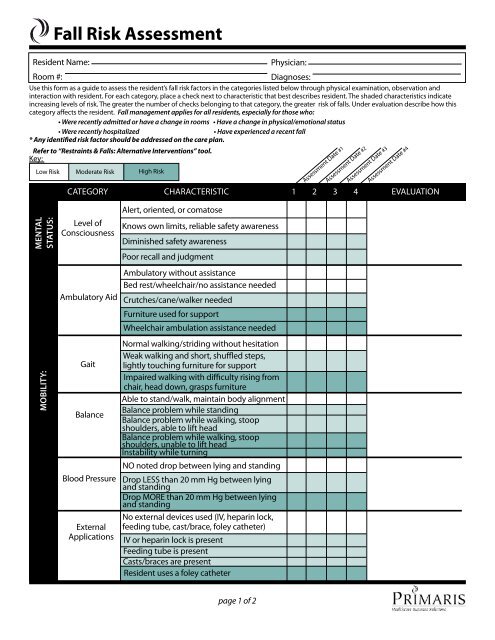The Main Principles Of Dementia Fall Risk
The Main Principles Of Dementia Fall Risk
Blog Article
Dementia Fall Risk for Beginners
Table of ContentsEverything about Dementia Fall RiskExcitement About Dementia Fall RiskThe smart Trick of Dementia Fall Risk That Nobody is Talking AboutSome Known Details About Dementia Fall Risk 4 Simple Techniques For Dementia Fall Risk
Assessing loss threat aids the whole health care group develop a safer environment for each client. Make certain that there is an assigned location in your medical charting system where staff can document/reference scores and record appropriate notes connected to fall prevention. The Johns Hopkins Autumn Danger Evaluation Tool is one of many devices your staff can make use of to aid stop damaging clinical events.Client falls in medical facilities are usual and devastating damaging events that linger regardless of years of initiative to minimize them. Improving interaction throughout the analyzing nurse, care group, client, and client's most included family and friends may enhance autumn prevention initiatives. A team at Brigham and Women's Medical facility in Boston, Massachusetts, looked for to develop a standard fall prevention program that focused around boosted interaction and person and family members involvement.

The advancement team stressed that effective implementation depends upon client and staff buy-in, integration of the program into existing process, and fidelity to program processes. The team noted that they are grappling with just how to make sure continuity in program application throughout durations of dilemma. During the COVID-19 pandemic, as an example, a boost in inpatient falls was linked with restrictions in individual interaction together with limitations on visitation.
Unknown Facts About Dementia Fall Risk
These occurrences are typically taken into consideration avoidable. To implement the intervention, companies require the following: Access to Fall ideas resources Fall ideas training and re-training for nursing and non-nursing staff, consisting of new registered nurses Nursing process that permit for patient and household involvement to conduct the drops assessment, guarantee usage of the prevention strategy, and carry out patient-level audits.
The outcomes can be highly destructive, frequently accelerating patient decline and triggering longer hospital remains. One research approximated keeps boosted an extra 12 in-patient days after a patient autumn. The Autumn TIPS Program is based on interesting clients and their family/loved ones across 3 major procedures: assessment, personalized preventative treatments, and bookkeeping to make certain that clients are taken part in the three-step loss avoidance process.
The patient assessment is based on the Morse Autumn Range, which is a verified loss danger analysis tool for in-patient health center setups. The scale consists of the 6 most common reasons clients in health centers fall: the patient loss background, high-risk problems (consisting of polypharmacy), usage of IVs and various other exterior devices, mental status, gait, and movement.
Each risk element links with several actionable evidence-based interventions. The registered nurse develops a strategy that integrates the treatments and shows up to pop over here the treatment team, client, and family members on a laminated poster or published aesthetic help. Nurses create the plan while meeting with the patient and the patient's family members.
Not known Details About Dementia Fall Risk
The poster offers as an interaction device with other participants of the individual's care group. Dementia Fall Risk. The audit element of the program includes evaluating the individual's expertise of their danger variables and avoidance plan at the unit and medical facility degrees. Registered nurse champions perform a minimum of 5 private interviews a month with people and their families to examine for understanding of the autumn prevention strategy

An approximated 30% of these drops result in injuries, which can vary in seriousness. Unlike various other adverse events that call for a standardized professional action, fall avoidance depends highly on the demands of the patient.
The Buzz on Dementia Fall Risk

Based on bookkeeping outcomes, one site had 86% conformity and two websites had more than 95% conformity. A cost-benefit analysis of the Fall pointers program in eight medical facilities approximated that the program expense $0.88 per client to execute and caused savings of $8,500 per 1000 patient-days in direct prices connected to the prevention of 567 tips over 3 years and eight months.
According to the innovation group, companies thinking about applying the program ought to carry out a readiness analysis and falls avoidance voids analysis. 8 Furthermore, organizations must ensure the needed infrastructure and process you could try these out for execution and establish an execution strategy. If one exists, the company's Fall Avoidance Task Force need to be involved in preparation.
An Unbiased View of Dementia Fall Risk
To begin, companies must ensure completion of training modules by nurses and nursing assistants - Dementia Fall Risk. Health center team must examine, based on the needs of a medical facility, whether to utilize a digital health and wellness document printout or paper version of the loss avoidance strategy. Executing teams should recruit and train nurse champions and establish procedures for auditing and reporting on fall data
Staff need to be associated website here with the procedure of revamping the workflow to engage clients and household in the assessment and avoidance plan procedure. Systems needs to be in place to make sure that systems can understand why a fall occurred and remediate the reason. Extra especially, registered nurses need to have networks to supply continuous comments to both staff and unit management so they can readjust and enhance loss prevention operations and interact systemic issues.
Report this page